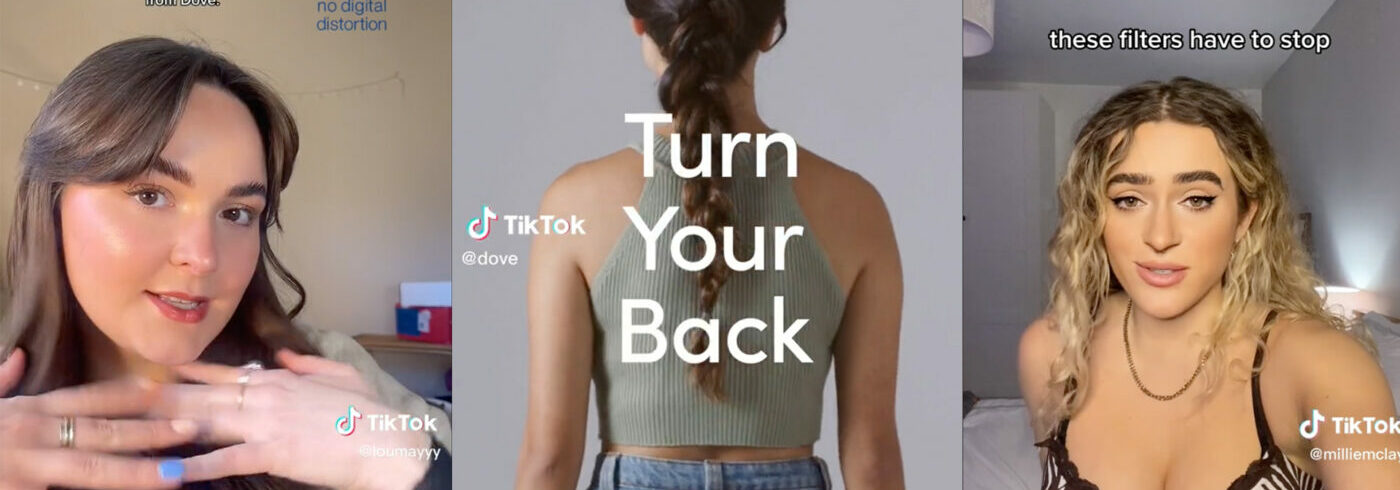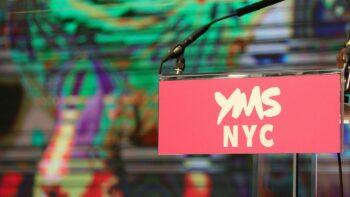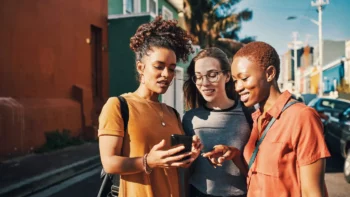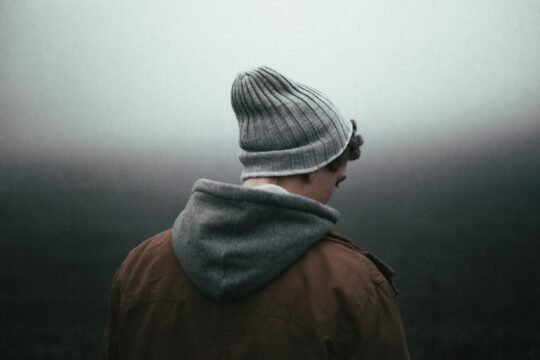
Bold Glamour: When Filter Merges With Reality
Article Highlights
- The road to picture perfect
- Introducing Bold Glamour
- The concern?
- What effect is this having?
- The online/offline matrix
- A social-first generation
- The deep-fake problem
- Creator backlash
- Head of Influencer Marketing at Student Beans, Ruby Soave shares:
- #TurnYourBack on Bold Glamour
- Other notable brand mentions
- Final takeaways
Be the first to access new posts and exclusive content
The selfie has had a pretty long lineage.
Typically taken at arms length, with a downward-facing angle to elongate the face, selfies are part-and-parcel of the social media sphere. They’ve even infiltrated the physical, if we count Kim Kardashian’s book. As time has evolved, however, so has the nature of our selfies. Duck faces, peace signs, protruding tongues. And, more recently, filter lenses.
In 2016, at perhaps the height of its platform, Snapchat launched an animated lens: the dog filter. Obsessively used by Kendall Jenner, Ariana Grande and Jessica Alba, Instagram feeds became inundated with this flattering canine-morphe. In fact, this year, Duchess of Sussex Meghan Markle revealed that it was a photo of her donning this filter that caused Prince Harry to slide into her DMs. Powerful stuff.
And, whilst we could talk about the dog filter all day, it’s not the object of concern here – but rather a starting point for something slightly more sinister.
In this blog, we look into the backlash directed at the ‘bold glamour’ filter on TikTok. We look at the dangerous effects and precedent that this filter sets for Gen Z, and look into how brands are getting involved in this conversation.
The road to picture perfect
Editing photos isn’t an uncommon feat. We all want to look our best; especially online, where digital perception is key. It’s a technological love story: likes roll in, self-esteem goes up.
Editing apps like Facetune capitalised on this sentiment, using a freemium model that allowed users to pay a mere $5.99 to unlock all features. In 2017, Facetune was Apple’s most popular paid app.
By 2022, it had generated over 4.6 million downloads. Then came FaceApp, a transformative face editor that uses AI to change the user’s appearance. Whether you want to look older, younger, or just more glamorous, FaceApp has it all – except for one key component: video.
Introducing Bold Glamour
Bold Glamour is a TikTok filter. It recently went viral for its hyper-realistic, visually altering features. Downloaded over 16 million times since its release, the filter reads skin tones, gender and hair colour, and then uses this information to overlay a primed, model-esque face.
The concern?
It’s seamless. Contrary to other filters, Bold Glamour doesn’t falter when the user moves around. It blends flawlessly into the user’s face, enhancing natural features to give the user the ultimate, undetectable glow-up.
Contrary to other filters, Bold Glamour uses a different kind of artificial intelligence – a “generative adversarial network”.
Luke Hurd, an augmented reality consultant at Snapchat, shared concerns about this kind of AI in a video on Twitter. He shared that the filter works by “taking images that have been fed into a database”, reading parts of the users face and then “essentially trying to match them”.
What effect is this having?
Experts have long been concerned about the effect these filters are having on young consumers. Research already suggests social media has a negative effect on young people, whilst there are wider concerns that these kinds of filters are causing young people to undergo cosmetic procedures.
According to the American Journal of Cosmetic Surgery, “the use of face-altering software on social media has a significant association with a desire to undergo facial cosmetic procedures”.
The online/offline matrix
It’s not uncommon to show photos for inspiration when undergoing a beauty procedure. We’ve all strolled to the hairdressers, armed with images of a bouncy-blow out, or a sleek set of highlights at some point. But, when these beauty procedures enter the cosmetic arena, the conversation becomes a little more tricky.
Take lip filler, for example.
Coming into discourse after Kylie Jenner became famed for her plump pout, cosmetic practitioners began to offer treatments in her namesake, promising consumers an enviable treatment to match.
A social-first generation
When Jenner eventually got her filler dissolved, the cyclical nature of this trend came into full swing. In the UK, influencer Molly Mae followed suit, and so on.
Social media plays a huge role here – constant exposure online has caused a breeding ground for plastic surgery trends. Young consumers are particularly affected, with one US surgeon claiming a third of her patients are Gen Z. The biggest consumers of social media? This same demographic.
And whilst before, consumers would show photos of their favourite celebrities for beauty inspiration, they’re now turning inwards – and showcasing edited photos of themselves. Aesthetician Dr Ahmed El Muntasar shared in Marie Claire that “people are bringing in photos of themselves that have been edited so much that they don’t look human anymore, and it’s unachievable”.
The deep-fake problem
The hyper-realism of this filter is part of another wider internet safety problem: deepfakes.
Deepfakes are videos or media that use artificial intelligence to show people doing things that never really happened. The dangers of this were recently shared in a BBC3 documentary.
When Bold Glamour is used on TikTok, the video signifies that the filter has been overlaid. However, once the video has been saved, this warning disappears, making it increasingly more difficult to believe what’s real online.
One researcher shared to The Washington Post that Bold Glamour “is a sign that very soon, technology that creates deep fakes can also be mainstreamed”.
Creator backlash
We recently wrote about the de-influencing trend, and how creators are using their platforms to share content that flips the script on traditional social media marketing.
Creators often build their audiences by showcasing aspirational lifestyles. And, whilst beauty plays a big role here, some creators are going a step further and renouncing the unrealistic beauty standards of the online world.
A sub-trend from the Bold Glamour filter has seen creators use the filter in a comparative style. One creator shared in a video that “filters push to impressionable young girls that they need to look like this to be considered beautiful, and that is so not the case”.
Several other content creators have also spoken up.
…Even Katherine Heigl even got involved in the conversation.
We reached out to creators who work with Student Beans, Voxburner’s sister company, to share their thoughts.
One said that they were “in shock” when they first saw the filter appear, stating that it saddened them that “impressionable young people will look at this filter and compare themselves, even though it’s not real”.
Head of Influencer Marketing at Student Beans, Ruby Soave shares:
“Gen Z are digital natives, who constantly challenge our industry to adapt quickly, and do better. I for one am grateful for the positive direction they are moving us all toward: namely (and not limited to) improved commitments and marketing regarding purpose, sustainability, diversity and inclusion and mental health…
Brands, whilst we’re here, let’s collectively commit to not using beauty filters within our marketing, please. We know the damage this can cause to all audiences – and it really needs to stop.”
#TurnYourBack on Bold Glamour
Brands are also getting involved in this conversation. Dove recently kickstarted a campaign in response to Bold Glamour.
The influencer-led #TurnYourBack campaign galvanised people to stand together, and physically turn their backs on this form of digital distortion.

The campaign comes off the back of research that saw 80% of girls in the US saying they have already applied a filter or used a retouching app to change the way they look by age 13.
The brand shared that Bold Glamour “reinforces the damaging beauty standards that Dove has been working hard to shatter”, and follows a number of social media campaigns including #SpeakBeautiful and #DetoxYourFeed.
Other notable brand mentions
The beauty industry has long been fraught with accusations of promoting unrealistic standards, but brands are taking a stand in a refreshing (and welcome!) turn of events.
Boots and Barry M are amongst the other brands who have pledged to stop the digital altering of bodies and faces of influencers, whilst H&M in 2018 became the first high-street giant to not airbrush their models.
Final takeaways
Recognising the toxic nature of the online world is key to directing change within it. As Gen Z searches for ethical values and responsibility, we hope the Bold Glamour filter is the catalyst for invoking a wider conversation.
Want more content from us? Subscribe to our Weekly Briefing and have the latest insights, research and Gen Z trends delivered to your inbox every week.



